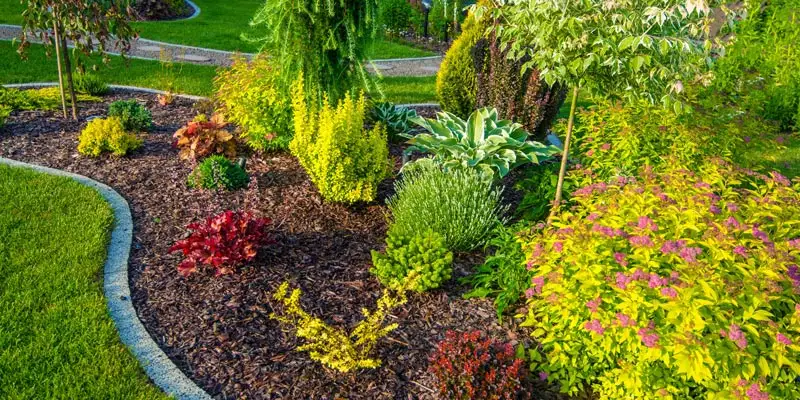Landscape Design Fundamentals Explained

The outside wall of your house often acts as the very first wall surface or beginning factor of an outdoor room. Inappropriate uses should be divided, and associated activities, such as cooking and dining, need to be created to make the lawn much more effective and satisfying. When making use of hardscape to develop areas, use construction material comparable to that used in the house for continuity from the home into the garden.
Linked rooms. Credit History: Gail Hansen, UF/IFAS Utilizing similar hardscape features and repeating plants pulls the eye around the yard. Vital points along the road can be emphasized with growings or features that draw attention and motivate motion in a certain instructions. Relocating along the course takes a person from one area to the next and permits the individual to have a variety of experiences.
This provides a feeling of secret that advertises exploration and discovery of the landscape. From a layout perspective, plant products have three significant functions in the landscape: visual, architectural and practical. Cosmetically, plants create an aesthetically pleasant setting and structurally plants arrange and define rooms. Plants are utilitarian because they can change the atmosphere for the comfort of the customer by changing light, temperature and moisture.
Landscape Design - The Facts
For mental comfort plants are used as physical or implied barriers for personal privacy and safety. Physical obstacles obstruct both the view and access to a room and include fences, walls and plant bushes. Landscape Design. Implied obstacles, normally low growing plants, block gain access to yet not the view (Figure 9). Various other features of plants include cleaning up the air, preventing erosion and dirt loss, maintaining moisture in the soil, and returning raw material to the dirt.
Physical and implied obstacles. Debt: Gail Hansen, UF/IFAS For these factors, the types of plants to be made use of (such as trees, hedges, or groundcovers) should be picked in the beginning of preparation. Plant kinds are selected for their functional abilities to make sure that right here their future purpose and called for area can be taken into consideration at the same time.
The above airplane, the vertical plane and the ground plane ought to all be thought about to develop unit. As soon as the shape of a plant bed has actually been established, the plants ought to be massed (organized) and split to achieve visual unity and the desired quantity of room. The size of a plant mass will certainly rely on the complete size of the lawn, the dimension of the private plants in the mass, and the emphasis or influence wanted from the plant product.
Each plant mass is in front of, behind, or following to, another mass. Credit Rating: Gail Hansen, UF/IFAS Duplicating plants within a mass and repeating masses with comparable plants connects the garden with each other. The individual plant features have to be taken into consideration to efficiently layer and mass plants.
A Biased View of Landscape Design
All plant structures start with the main structure plants, the large, mostly evergreen background plants-such as the trees and large shrubs. These plants separate or enframe spaces, manage the dimension of the room, and offer the starting point for selecting the suitable characteristics more information of the second layer, midground plants, for massing and infill.
Vital factors in the yard need to be highlighted by the usage of special plants, distinctive frameworks, or garden ornaments. Marking limits or entryways to spaces can be performed with entrances, arbors, and steps, or through using one-of-a-kind and vivid plants. The type and/or style motif of the garden will often assist identify the important points and exactly how they need to be highlighted.
Other important places in the yard are focal points, which is utilized to aesthetically arrange a designed location. Different point of views or perspectives can disclose different compositions in the landscape that may call for a range of focal factors.
The Greatest Guide To Landscape Design
Number 13. Plant types. Credit Score: Gail Hansen, UF/IFAS After form, appearance is the following leading feature of a plant; coarse, tool and great appearances can be used for contrast and emphasis in the landscape. Form and structure both trump shade in the yard for the majority of the year. During specific periods, shade will certainly be the most obvious feature of the yard.


The pleasant aroma of plants, the audio of wind in the trees, the audio and structure of water, and the shades and structures of sculptures, pots and yard furniture all include in the experience of the yard. One information that is typically overlooked is the impact of light on the appearances of the plants.
The entire yard modifications in feature and appearance over the course of the day, and the her latest blog training course of a year, as the light and temperature level adjustment from morning to evening and season to season. Plant option need to consider a plant's development rate, its fully grown size and kind, and the maintenance it will call for.
It is necessary to know the ultimate fully grown size of plants so they can be put in the right location and spaced correctly when they are installed. Providing plants space to expand is an obstacle because the common fully grown dimension is typically based on optimum expanding problems and the ecological problems of a website might trigger a plant to grow larger or stay smaller.
Comments on “Facts About Landscape Design Uncovered”